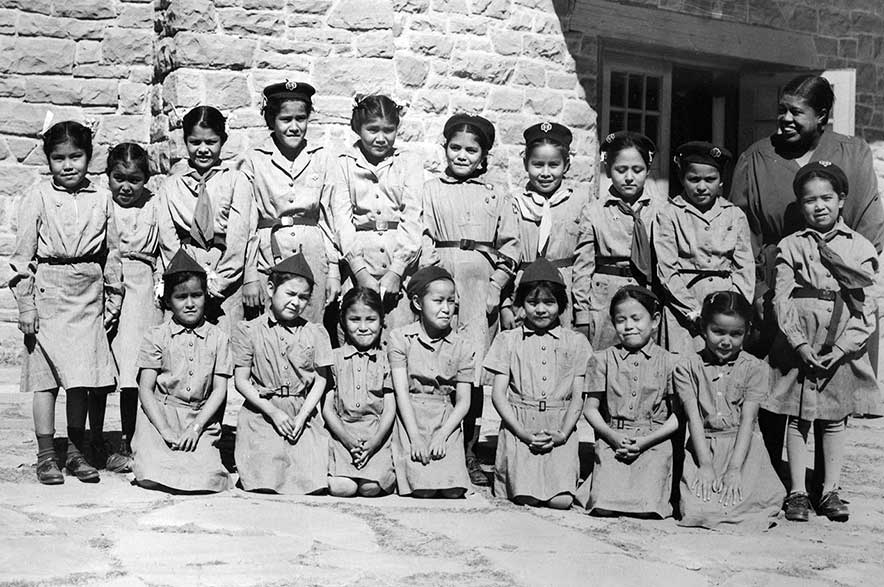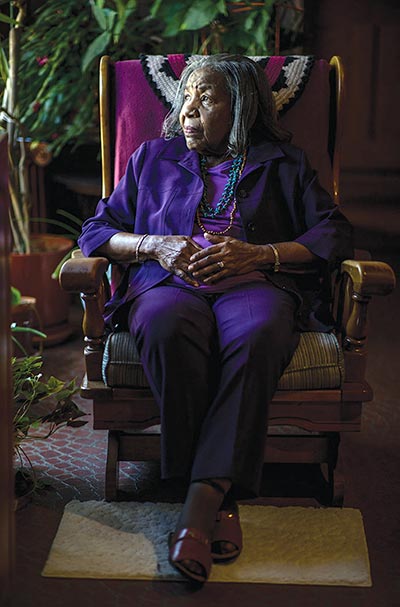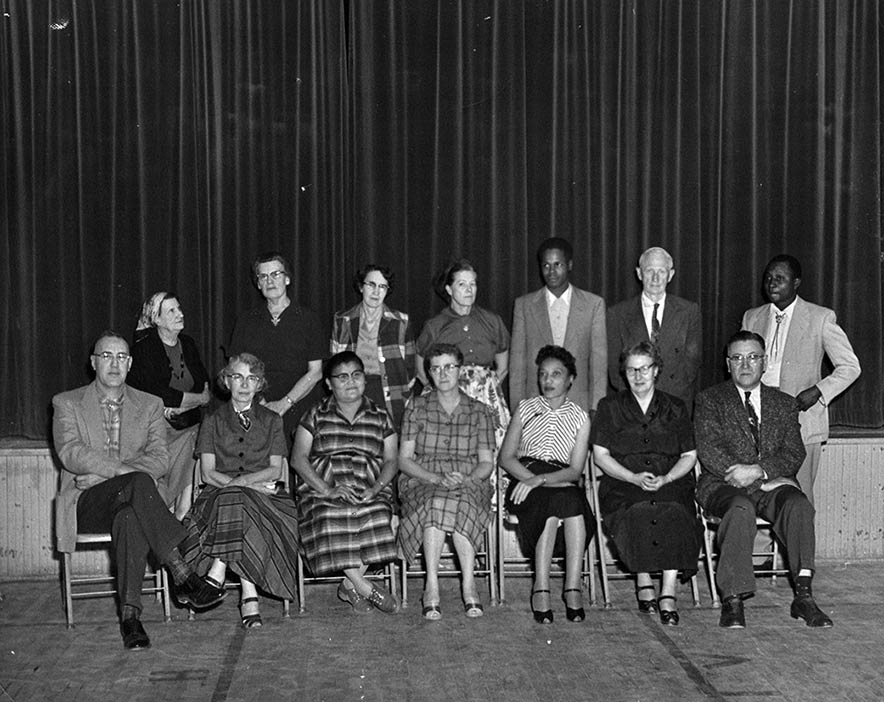
Intertwined threads: Black, Diné history often converge

Courtesy photo
In this undated photo by Milton Snow (possibly 1963-64), an African-American teacher, right, probably Evelyn Juanita Waithall Archibald, stands with a Navajo Girl Scout troop in Kinlichee, Ariz. Over the years, thousands of African-Americans have come to the reservation to teach and many led extra-curricular activities in their free time.
CHINLE
African-American and Indigenous history are colorful intertwined threads that run through the tapestry of the American story, sometimes unnoticed in the dense fabric and sometimes prominently displayed.
Here on the Navajo Nation, the threads have converged and diverged over the centuries, but there is no doubt the two cultures have influenced and complemented each other in subtle but powerful ways.
Although Black folks have been in the Southwest since the 16th Century (as slaves of the Spanish settlers), and the famed “Buffalo Soldiers” fought alongside Navajo Scouts during the Apache wars of the 1860s through the 1880s, a longer and more intimate connection was forged from the 1920s to the present, when African-American teachers came to the reservation to help staff the remote mission and BIA schools.

Navajo Times | Sharon Chischilly
Richard Beyal Jr., 93, remembers when the first African-American teacher came to the BIA school in Lake Valley, N.M., some time in the 1930s. Some parents stopped sending their children to school because the children were afraid of her.
Ninety-three-year-old Richard Beyal Jr. remembers the hubbub when the first Black teacher arrived to teach kindergarten and first grade at the tiny BIA school in Lake Valley, New Mexico, some time in the 1930s.
“Most of the kids had never seen a Black person before,” he recalled. “They were afraid of her. The parents stopped sending their kids to school and the BIA had to have meetings at the chapter house where they explained they couldn’t get enough white teachers at the school. “I guess the white people thought we were too wild,” he mused. “But we weren’t wild. The white people who were coming on the reservation at that time were more wild than us.”
Beyal’s childhood assessment of the situation was not too far off, said Khalil Johnson, assistant professor of African-American Studies at Wesleyan University, who is working on a book on Black educators in Native American schools. “There were very few Native teachers at that time, and the BIA was having a hard time finding white teachers who weren’t prejudiced,” Johnson explained. “They heavily recruited Blacks who had recently graduated from teachers’ colleges.”
Many African-American teachers were only too happy to leave the Jim Crow South for a steady federal government paycheck, even if it meant living in an isolated, undeveloped community deep within the reservation. But, ironically, the real boost to this trend didn’t come until 1954, when the landmark Brown v. Board of Education ruling came down, outlawing racial segregation in public schools.
The ruling was heralded as a major victory for civil rights, and it was — but as Johnson wrote in an article in the Journal of American Indian Education, it resulted in tens of thousands of African-American teachers losing their jobs, no longer welcome in the newly integrated school systems, especially in the South.
They were more than welcome on the rez, where the BIA was struggling to staff a growing school system. At the peak of the wave, estimates Johnson based on BIA censuses of teachers, about 40% of teachers in the BIA schools were Black.
One teacher’s story
Jeffie Lockett came to teach at Many Farms Community School in 1966. Her husband was stationed in Hawaii with the military and was getting ready to retire and pursue a college degree, “so somebody needed to support the family,” said Lockett, 93. While Lockett’s husband earned his degree at Northern Arizona University, she and their three children moved to Many Farms.
She doesn’t recall any discrimination aimed directly at her, “but my son, who was in second grade at that time, came home crying every day.” Recalling that her more assertive daughter had been pretty good at fending off racial bullying when the family lived in Japan, “I told him, ‘Whenever they bother you again, go get your sister. She’ll straighten them out.’” She did, and that was the end of the bullying.

Navajo Times | Sharon Chischilly
Jeffie Lockett, 93, taught on the Navajo Nation for more than two decades, first at Many Farms and then Leupp, Ariz.
Eventually Lockett transferred to Leupp Community School, where she joined two other African-Americans on the staff, Alex and Dorothy Renfro. Alex was the head cook and Dorothy was an elementary school teacher. For Diné/Nahilii musician and activist Radmilla Cody, then a student at the school, it made a huge difference to have Black folks on the faculty.
“Just seeing people who looked like me in those positions, it was really inspiring to me,” she recalled. “Mr. Renfro served us black-eyed peas and greens — soul food. He introduced some African-American culture to our school.” While there was the occasional racist comment, “for the most part, everyone loved and enjoyed” the African-American teachers, Cody recalled.
But off the reservation, it was a different story. If a Black teacher traveled to Gallup for a nice meal, noted a 1951 article in Ebony magazine, there was only one option: the Harvey House at the train station. No other restaurant in the border town admitted Blacks.
“It was enough of a problem that the BIA, as their employer, got involved,” said Johnson. The Black teachers were issued a card that could get them into the usually segregated Monte Vista Hotel in Flagstaff. When a teachers’ conference was scheduled at Grand Canyon National Park — whose hotels and restaurants were segregated then — BIA personnel ran ahead and made sure there would be rooms for the educators of color.
“You could argue that this large influx of African-Americans into the West hastened the progress of civil rights in the area,” said Johnson.
‘Very, very prejudiced’
By the time Lockett and her family moved to Flagstaff, the segregation was unofficial but still very real. “Flagstaff was a very, very prejudiced town,” she recalled. Almost the entire Black population lived south of the railroad tracks. Cody, who was born in 1975 and lived in Flagstaff as a young child, recalls the South Side as a joyful, close-knit Black and Brown community.
“You would walk down the street and everyone would be outside playing their music,” she said. “People got dressed up just to hang out. All the jiving and the culture, it was cool to see.”
Like the Navajos, the African-Americans placed a high value on k’e, Cody said. “You would call an older person ‘Auntie,’ ‘Uncle,’ ‘Grandpa,’ and they were,” she recalled, noting that her mother would often drop her off with her African-American friends in Flagstaff when she needed to run errands. “You could walk down the street at night and not worry. Everyone looked out for each other.”
Johnson, who volunteered with Teach for America in Thoreau, New Mexico, from 2005 to 2007, said he felt the same vibe as an African-American living among the Navajos. “Anthropologists call it ‘fictive kin,’ these relationships that are as strong as family ties,” he noted. “In the African-American community we have what we call ‘play cousins.’”
Another common thread Johnson found was the relationship between grandchildren and grandparents. “Like with the Navajo, I have several African-American friends who were raised by their grandparents,” he said. “Even if they don’t raise them, the grandparents have a lot of influence over their grandchildren’s lives.”
While Lockett also has happy memories of the South Side, where she still lives in spite of recent gentrification, she said it’s important to remember that the neighborhood came about because of segregation.
‘They put all our things here’

Courtesy photo
A 1950s photo of the Chinle Boarding School faculty features three Black teachers.
“The reason there were all these activities for Black people here was because they put all our things here,” she said. “The Black-owned businesses, the Black churches, Brannen Homes (public housing), the Cogdill (Recreation Center), the Duncan (Negro) School … all these things were on the South Side. The whites didn’t even have to see us if they didn’t want to.”
Crystal Warden-Gant, 43, an African-American who grew up in Flagstaff after her grandfather and father migrated to the town to work in the sawmills, agreed.
“It’s like they (the whites) said, ‘OK, you have your own stores, your own churches, your own bars; now we don’t have to deal with you,’” she said.
There was a “huge” number of Black millers and lumberjacks when the lumber industry was at its peak, but you never hear about them, she lamented.
“They came and they literally built this town that’s now thriving,” she noted, “but you can pick up a history book of Flagstaff and you would think there was never anybody but white people here.”
By the 1970s, segregation may have no longer been the law of the land, but there was nothing to prevent white-owned banks from making excuses not to loan Black folks money, and real estate agents steered African-Americans clear of certain neighborhoods even if they had the money to buy a home there.
Lockett recalled a light-skinned Black woman who purchased some property in Flagstaff hoping to build a home. When the sellers met her husband, who was quite a bit darker than she, they tried to scuttle the deal, she said.
And though Cody’s mother, Margaret Cody, and some other Navajos liked to hang out on the South Side, most did not. “The majority of the Navajos catered to the whites,” Lockett said. “They knew the whites were in the positions of power and able to help them if they needed something.”
Allies for justice
But the Navajos who did make Nahilii friends found valuable allies in the Civil Rights movement. “They learned from us and we learned from them,” said Robert Cooper, a 73-year-old African-American photographer who has lived on the South Side since he was six months old and has been an advocate for Flagstaff’s unsheltered population for 30 years. “The Blacks, the Hispanics, the Navajos — we’re all minorities here and we all faced the same struggles for employment and respect,” he said. “Basically we all have the same problem: the Anglos take all the jobs.”
Cody recalled the NAACP stepped in when she won the Miss Navajo pageant in 1997 and some objected that the crown should not go to a biracial woman.
Johnson noted that the group’s Farmington chapter called for justice in 1974 when white teenagers beat three Navajo men to death and were sent to reform school rather than prison, and Cody, who helped to organize protests after Loreal Tsingine was shot to death by police in 2014, was happy to see her old friends the Lands there — an African-American couple who owned a bar in Winslow. In turn, Johnson said, plenty of Natives marched for Black lives. “When the Red Nation held their conference in 2018, there was a Black Lives Matter banner hanging across the stage,” he recalled.
“We as Diné need to be reminded of how much a role our Nahilii relatives have played, standing in solidarity with us against the injustices we faced and continue to face,” Cody said.
That may be true, but after his own experience in Dinétah and studying the Black educators of the past, Johnson has mixed feelings about their role propping up a government-imposed education system that maybe should have been allowed to die.
“I am a 21st Century colonialist,” he wrote while teaching in Thoreau, “shaping young Navajos to work in the great white American world in the hope that they will be able to change society if they get access to power.”
Lockett doesn’t see it that way.
“I could appreciate what they were trying to do at Leupp School (with the Navajo language and culture classes),” she said, “but the kids didn’t have a clue what was going on in the outside world, and they needed to know that too. The only way to do that was to get them off the reservation.”
She got her students into off-reservation speech tournaments, statewide student council competitions and chaperoned dances in Flagstaff. Many students came back later and thanked her for “getting them out of their shell.”
Beyal thinks it was ultimately a good thing that people of other races came to the rez as educators, at least those who were respectful of Navajo culture.
“At first, the Navajos were afraid of the Black people and the white people were afraid of us,” he said. “We all got used to each other. It took a while.”
(Author’s note: Radmilla Cody was immensely helpful in reporting this story.)








 Highway 264,
Highway 264, I-40, WB @ Winslow
I-40, WB @ Winslow